#online teaching digital board
Explore tagged Tumblr posts
Text
Can't afford art school?
After seeing post like this 👇

And this gem 👇
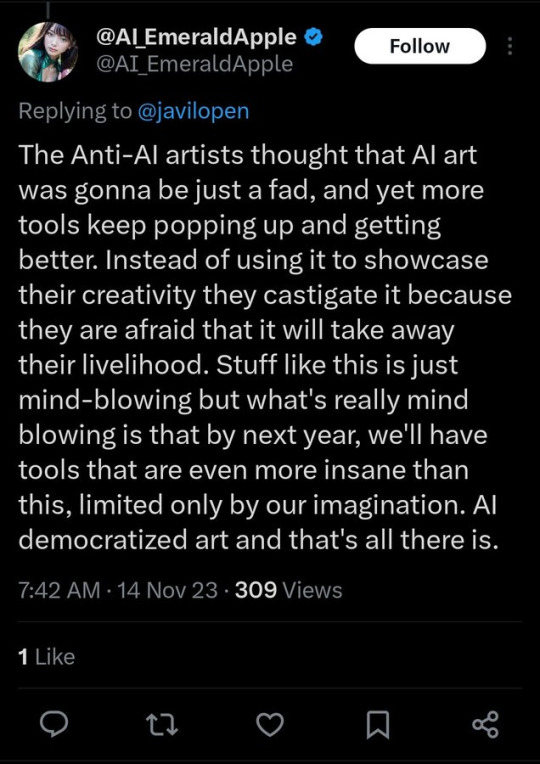
As well as countless of others from the AI generator community. Just talking about how "inaccessible art" is, I decided why not show how wrong these guys are while also helping anyone who actually wants to learn.
Here is the first one ART TEACHERS! There are plenty online and in places like youtube.
📺Here is my list:
Proko (Free, mostly teaches anatomy and how to draw people. But does have art talks and teaches the basics.)
Marc Brunet (Free but he does have other classes for a cheap price. Use to work for Blizzard and teaches you everything)
Aaron Rutten (free, tips about art, talks about art programs and the best products for digital art)
BoroCG (free, teaches a verity of art mediums from 3D modeling to digital painting. As well as some tips that can be used across styles)
Jesse J. Jones (free, talks about animating)
Jesus Conde (free, teaches digital painting and has classes in Spanish)
Mohammed Agbadi (free, he gives some advice in some videos and talks about art)
Ross Draws (free, he does have other classes for a good price. Mostly teaching character designs and simple backgrounds.)
SamDoesArts (free, gives good advice and critiques)
Drawfee Show (free, they do give some good advice and great inspiration)
The Art of Aaron Blaise ( useful tips for digital art and animation. Was an animator for Disney. Mostly nature art)
Bobby Chiu ( useful tips and interviews with artist who are in the industry or making a living as artist)
Sinix Design (has some tips on drawing people)
Winged canvas (art school for free on a verity of mediums)
Bob Ross (just a good time, learn how to paint, as well as how too relax when doing art. "there are no mistakes only happy accidents", this channel also provides tips from another artist)
Scott Christian Sava (Inspiration and provides tips and advice)
Pikat (art advice and critiques)
Drawbox (a suggested cheap online art school, made of a community of artist)
Skillshare (A cheap learning site that has art classes ranging from traditional to digital. As well as Animation and tutorials on art programs. All under one price, in the USA it's around $34 a month)
Human anatomy for artist (not a video or teacher but the site is full of awesome refs to practice and get better at anatomy)
Second part BOOKS, I have collected some books that have helped me and might help others.
📚Here is my list:
The "how to draw manga" series produced by Graphic-sha. These are for manga artist but they give great advice and information.
"Creating characters with personality" by Tom Bancroft. A great book that can help not just people who draw cartoons but also realistic ones. As it helps you with facial ques and how to make a character interesting.
"Albinus on anatomy" by Robert Beverly Hale and Terence Coyle. Great book to help someone learn basic anatomy.
"Artistic Anatomy" by Dr. Paul Richer and Robert Beverly Hale. A good book if you want to go further in-depth with anatomy.
"Directing the story" by Francis Glebas. A good book if you want to Story board or make comics.
"Animal Anatomy for Artists" by Eliot Goldfinger. A good book for if you want to draw animals or creatures.
"Constructive Anatomy: with almost 500 illustrations" by George B. Bridgman. A great book to help you block out shadows in your figures and see them in a more 3 diamantine way.
"Dynamic Anatomy: Revised and expand" by Burne Hogarth. A book that shows how to block out shapes and easily understand what you are looking out. When it comes to human subjects.
"An Atlas of animal anatomy for artist" by W. Ellenberger and H. Dittrich and H. Baum. This is another good one for people who want to draw animals or creatures.
Etherington Brothers, they make books and have a free blog with art tips.
📝As for Supplies, I recommend starting out cheap, buying Pencils and art paper at dollar tree or 5 below. If you want to go fancy Michaels is always a good place for traditional supplies. They also get in some good sales and discounts. For digital art, I recommend not starting with a screen art drawing tablet as they are usually more expensive.
For the Best art Tablet I recommend either Xp-pen, Bamboo or Huion. Some can range from about 40$ to the thousands.
💻As for art programs here is a list of Free to pay.
Clip Studio paint ( you can choose to pay once or sub and get updates. Galaxy, Windows, macOS, iPad, iPhone, Android, or Chromebook device. )
Procreate ( pay once for $9.99 usd, IPAD & IPHONE ONLY)
Blender (for 3D modules/sculpting, animation and more. Free)
PaintTool SAI (pay but has a 31 day free trail)
Krita (Free)
mypaint (free)
FireAlpaca (free)
Aseprite ($19.99 usd but has a free trail, for pixel art Windows & macOS)
Drawpile (free and for if you want to draw with others)
IbisPaint (free, phone app ONLY)
Medibang (free, IPAD, Android and PC)
NOTE: Some of these can work on almost any computer like Clip and Sai but others will require a bit stronger computer like Blender. Please check their sites for if your computer is compatible.
So do with this information as you will but as you can tell there are ways to learn how to become an artist, without breaking the bank. The only thing that might be stopping YOU from using any of these things, is YOU.
I have made time to learn to draw and many artist have too. Either in-between working two jobs or taking care of your family and a job or regular school and chores. YOU just have to take the time or use some time management, it really doesn't take long to practice for like an hour or less. YOU also don't have to do it every day, just once or three times a week is fine.
Hope this was helpful and have a great day.
"also apologies for any spelling or grammar errors, I have Dyslexia and it makes my brain go XP when it comes to speech or writing"
85K notes
·
View notes
Text
youtube
How to Find a ODM/OEM Interactive Flat Panel Supplier?
Finding a suitable ODM (Original Design Manufacturer) or OEM (Original Equipment Manufacturer) for interactive flat panels involves several steps.
Here's a guide to help you through the process: 1. Define Your Requirements. - Specifications: Determine the specifications you need, such as screen size, resolution, touch technology (capacitive, optical, etc.), and additional features (e.g., compatibility with various operating systems, connectivity options). - Design: Consider any custom design or branding you require. - Quantity: Estimate the volume of your initial order and future orders. 2. Research Potential Suppliers - Online Platforms: Use B2B platforms such as Alibaba, Global Sources, or Made-in-China to find suppliers. Check their product offerings and request quotes. - Industry Associations: Look for manufacturers listed in industry-specific associations or trade directories. - Trade Shows: Attend trade shows related to electronics, AV technologies, or educational technology, where you can meet potential suppliers in person 3. Evaluate Suppliers - Company Reputation: Research the supplier's reputation through online reviews, testimonials, and references. - Certifications: Ensure the suppliers have necessary quality certifications (ISO, CE, RoHS, etc.) that meet your region's regulatory requirements. - Experience: Check how long the supplier has been in business and their experience with interactive flat panels. 4. Request Samples - Before making a large order, request samples to test the quality, performance, and functionality of their products. 5. Assess Communication and Support - Responsiveness: Evaluate how promptly and effectively they respond to inquiries. - Language Barrier: Ensure that language is not a barrier in communication. - Customer Service: Assess their customer service quality for post-purchase support.
6. Negotiate Terms - Discuss pricing, minimum order quantities, lead times, payment terms, and warranty options. - Make sure to get everything in writing. 7. Verify Production Capabilities - If possible, visit the factory to assess their production lines, quality control processes, and capacity. - Ensure they have the capability to scale production as your business grows. 8. Evaluate Logistics and Shipping - Discuss shipping options, costs, and timelines. Consider the implications of customs regulations if sourcing from overseas.
9. Legal Considerations - Draft and review contracts carefully to protect your intellectual property and ensure quality standards. 10. Build a Relationship - Once you find a suitable supplier, work on developing a strong business relationship to facilitate better communication and cooperation in the long run. Additional Resources: - Industry Reports: Consult market research reports for insights into industry trends and key players in the interactive flat panel market. - Networking: Leverage professional networks and forums to get recommendations and insights from others in the industry. By following these steps, you should be able to find a reliable ODM/OEM interactive flat panel supplier that meets your needs.
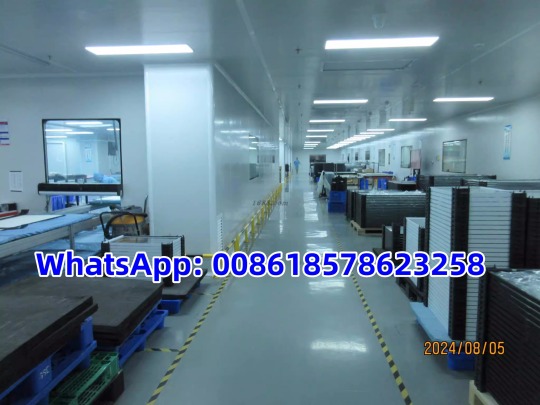
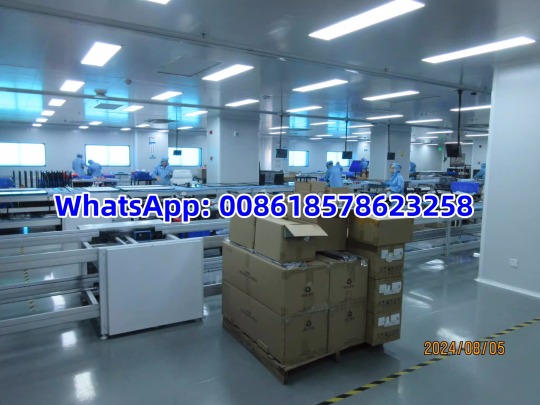
#budget digital board 2024#budget smart board 2024#smart board#low cost interactive whiteboard#cheapest interactive flat panel#cheap smart board 2024#best digital whiteboard for teaching#smart board for online teaching#best smart class solution#smart board with ops#Interactive Flat Panel#ifp#smart board for teaching#smart board projector#interactive touch board#interactive flat panel#interactive whiteboard#top 5 best interactive smart board#Interactive Displays#Youtube
1 note
·
View note
Text
#coaching#online coaching#online teacher#online tutoring#teacher#teaching#tutor#digital board#studio setup#home studio setup#Evota smart board#best studio provider#best studio provider in India#online teaching Studio setup#evota camera
1 note
·
View note
Text
Exploring Augmented Reality Board Games: Enhancing the Gaming Experience
Augmented reality board games represent an exciting frontier in gaming, offering a unique blend of physical and digital interaction that appeals to players of all ages. With continued advancements in AR technology and creative game design, the possibilities for immersive and engaging gaming experiences are endless. Whether hunting for treasure in their own backyard or saving the world from ghosts in their neighborhood, players can look forward to a new era of interactive entertainment with augmented reality board games.
0 notes
Text
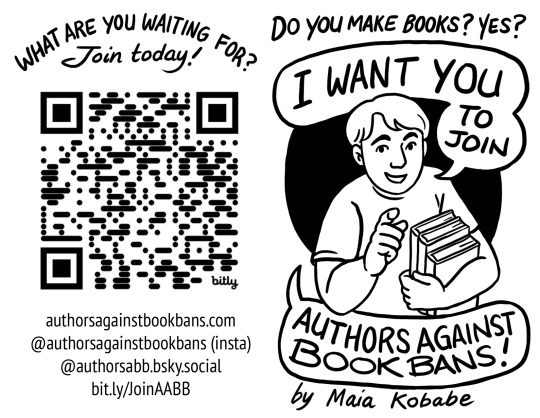
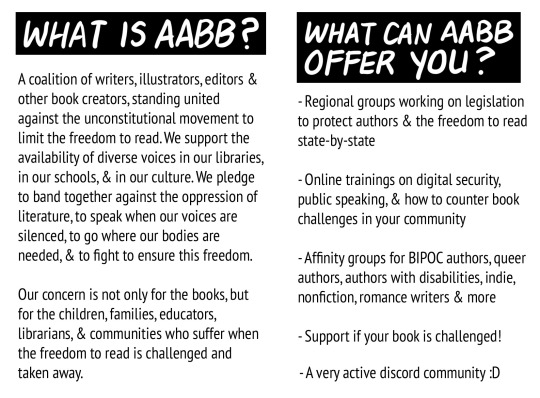
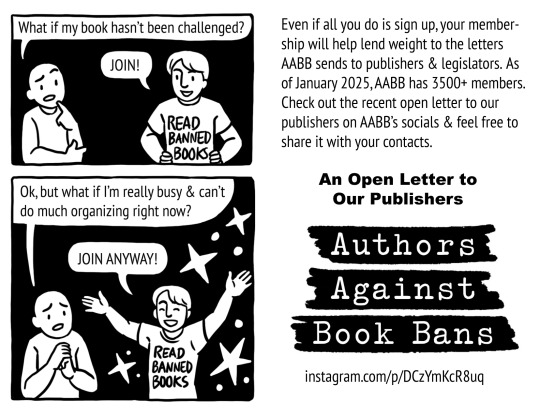
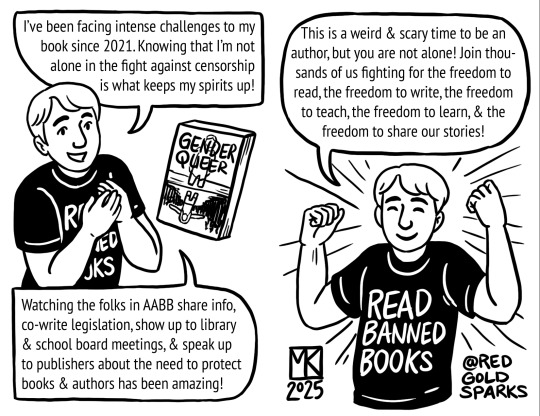
Has your name every appeared in the credits of a book, or is it likely to in the near future? Then you should join AUTHORS AGAINST BOOK BANS! Transcript below the cut. A version of this zine formatted for print is available to download on my patreon.
Do you make books? Yes? I want YOU to join Authors Against Book Bans! By Maia Kobabe
WHAT IS AABB?
A coalition of writers, illustrators, editors & other book creators, standing united against the unconstitutional movement to limit the freedom to read. We support the availability of diverse voices in our libraries, in our schools, & in our culture. We pledge to band together against the oppression of literature, to speak when our voices are silenced, to go where our bodies are needed, & to fight to ensure this freedom.
Our concern is not only for the books, but for the children, families, educators, librarians, & communities who suffer when the freedom to read is challenged and taken away.
WHAT CAN AABB OFFER YOU?
- Regional groups working on legislation to protect authors & the freedom to read state-by-state
- Online trainings on digital security, public speaking, & how to counter book challenges in your community
-Affinity groups for BIPOC authors, queer authors, authors with disabilities, indie, nonfiction, romance writers & more
-Support if your book is challenged!
-A very active discord community
Author: What if my book hasn’t been challenged?
Maia: JOIN!
Author: Ok, but what if I’m really busy and can’t do much organizing right now?
Maia: JOIN ANYWAY!
Even if all you do is sign up, your membership will help lend weight to the letters AABB sends to publishers & legislators. As of January 2025, AABB has 3500+ members. Check out the recent open letter to publishers on AABB’s socials & feel free to share it with your contacts.
An Open Letter to Our Publishers- instagram.com/p/DCzYmKcR8uq
Maia: I’ve been facing intense challenges to my book since 2021. Knowing that I am not alone in the fight against censorship is what keeps my spirits up!
Watching the folks in AABB share information, co-write legislation, show up to library & school board meetings, & speak up to publishers about the need to protect diverse books & minority authors has been amazing!
This is a weird & scary time to be an author, but you are not alone! Join thousands of us fighting for the freedom to read, the freedom to write, the freedom to teach, the freedom to learn, & the freedom to share our stories!
AABB on instagram / AABB on bluesky
1K notes
·
View notes
Text
6 major advantages of digital boards for classrooms

The new learning method that is being encouraged in schools across the country is digital boards in the classroom. These digital boards for teaching are replacing the existing traditional method of learning and enable students to learn with audio-visual content supporting both personalized learning as well as encouraging students’ participation for better results.
Discussed below are some of the advantages of Digital Boards
Engaging sessions enhancing participation
Students find lessons to be very interesting. Different research has proven that students learn better when they learn visually. It has also helped in developing retention rates amongst students in a better way. Teachers are also finding digital boards in the classroom to be the best and most effective medium for teaching where students are eager to come to the classes and enjoy the sessions with the available multimedia content.
Accessibility to the external resources
Access to a wide and relevant range of educational resources online. With the different resources for the same concept, students get multiple ways of solving questions, learning concepts, and different methodologies ensuring their growth. Digital boards for online teaching thus create an easy and approachable platform for teachers so that they can utilize available resources in explaining their sessions. The use of relevant videos provides enriched learning experiences with audio-visual learning.
Ensure more attentiveness in the classrooms
Digital learning solutions in the classroom help students increase attention to what’s being taught in the classrooms. Students can easily access the notes and save them with the available recording options to refer to later. Which ensures never to miss classes and also notes. Saving time from writing thus enables students to focus more on improving productivity.
Enriched learning experiences
These digital boards for schools are transforming complete learning methodologies of the classrooms creating a better learning ecosystem. The available multimedia content, effective assessment methods, different quiz tools, and screen-sharing options enhance maximum participation and audio-visual learning allowing learners to get to the concepts easily ensuring their academic excellence.
Option for multi-finger touch
Interest in teaching can be achieved with multiple-finger touch recognition with senses. Writing using a dual-tip point stylus enable annotation on the text to give students to mark important points, create explanatory remarks, helping them focus and pay attention in class. The multiple-finger touch option allows the palm to erase written things on displays.
Enables students to work together
The ability for students to simultaneously draw and write on the same board inspires creativity and transforms a regular classroom into a collaborative one.
Teaching can be more fluid for both the teacher and the students in a classroom with interactive digital boards. Without ever having to worry that the classes aren't dynamic enough, teachers may always come up with fresh and interactive methods to use digital boards.
#Digital Board#digital board for teaching#digital board for education#interactive digital board price india#digital board for online teaching#digital board for teaching online
0 notes
Text
When Matt Williams founded a research center for the Anti-Defamation League in 2022, he vowed to “ruthlessly and systematically test” what the organization does. Antisemitism was on the rise, and he wanted the Center for Antisemitism Research to scientifically study what could work to stop it.
The creation of the center, he believed, represented an admission that one of the world’s most prominent voices against antisemitism had been operating with little evidence.
“I would go a step further and say the ADL wants to be a serious nonprofit, measured on our social return on investment, but by a lot of measures, we’ve not been doing well,” Williams said in an interview, citing spiking antisemitism, rising extremism and the erosion of democratic norms around the world.
The ADL established the new center amid mounting pressure from funders and trustees, he added. “The level of tolerance for having no solutions is low right now,” Williams said. “Our Board of Trustees is very serious about ruthlessly holding us accountable to whether or not we’re solving the problems that we set out to solve.”
Here’s how the person recently elected as ADL’s board chair put it: “Flagging and monitoring and measuring antisemitism is important, but by itself will not reverse trends towards extremism, bias and radicalism in American or global society,” Nicole Mutchnik said in an email to the Jewish Telegraphic Agency.
Now, with a staff of nine and about 70 affiliated researchers at universities around the country, the research program overseen by Williams is starting to flex its scholarly might. It recently unveiled, for example, the first scientific study in decades that focuses on anti-Jewish discrimination in hiring.
Previous studies by the center showed that antisemitic attitudes are more strongly correlated with conspiratorial beliefs than any other factor. So, now, it has partnered with a team of university researchers to examine whether correcting misinformation can make a difference.
“We’ve found that we have a better shot at reducing antisemitism by teaching people how to deal with misinformation and disinformation than we have with much of the anti-bias work that we’ve done previously,” Williams said. “Thinking of antisemitism as a digital literacy problem as opposed to a civil rights problem is a big change for ADL.”
Alarm about antisemitism in recent years has driven a doubling of donations to the ADL, topping $100 million in 2022, the most recent year for which complete data is available. It has also sparked the creation of dozens of new organizations and initiatives, including some that are directly critical of the ADL’s approach or are trying to fill perceived gaps.
Many, including Bari Weiss, author of “How to Fight Antisemitism,” prescribe embracing Judaism and Jewish pride. Others are looking to tech for solutions. At least one group focuses on naming and shaming alleged antisemites online. Author Dara Horn says the answer lies in deemphasizing the Holocaust and educating the public about living Jews and their culture. Jewish communal organizations have also poured millions of dollars into physical security measures at schools, synagogues and other Jewish institutions.
The Biden administration in 2023 published a plan featuring hundreds of detailed recommendations, many of which are modeled on ADL’s platform. The plan proposes, for example, streamlined hate crime reporting at all levels of law enforcement and more accommodation for Jewish religious observance in the workplace.
On the right, the Heritage Foundation’s Project Esther proposes a government crackdown on anti-Israel groups once Donald Trump returns to the White House. Meanwhile, left-wing groups like Diaspora Alliance and Jews for Racial and Economic Justice say that effectively responding to antisemitism requires building solidarity with Palestinians and other groups they view as oppressed.
Even as viewpoints and tactics vary, there’s a consensus in the Jewish community that fighting antisemitism must mean more than sounding the alarm about the issue. As a result, the search for evidence-based solutions, grounded in social science research, is starting to gain traction.
“We need to be moving more research resources into what’s working and what’s not working,” Holly Huffnagle, the U.S. director for combating antisemitism at the American Jewish Committee, said in an interview. “Many of us in the Jewish world are talking about this.”
Huffnagle said the AJC, considered a peer to the ADL in terms of size and legacy, doesn’t currently sponsor academic, peer-reviewed research, but that such a program could transform the work of her organization.
“If we find that our interventions aren’t working we need to be comfortable and competent to move away from what we were doing in the past,” she said. “Do we have information about what’s actually changing hearts and minds?”
To help answer that question, a pair of political scientists specializing in a field they call “deep canvassing” are using a grant from the ADL to research what kinds of narratives about Jews, when presented to people, can be effective at reducing prejudice. The researchers, David Broockman from the University of California, Berkeley and Josh Kalla from Yale University, have previously demonstrated the effectiveness of the technique in the context of bias against transgender people.
For their new study, the researchers made two-minute video clips featuring eight types of narratives about Jews and showed them over the internet to an audience of about 23,000 survey respondents.
Watching all eight narrative types led to a drop in prejudice, but some had a much stronger effect than others. For example, bipartisanship — a video showing both Donald Trump and Joe Biden condemning antisemitism — proved more impactful than a video depicting a fictional Jewish character suffering, but far less impactful than a video that presented the suffering as the result of discrimination.
Another sign of the awakening underway is the spate of new university programs focused on the study of antisemitism. Gratz College, a Jewish institution for higher education in Philadelphia, now offers a master’s degree in the topic. New York University, the University of Michigan, and the University of Toronto have all made recent investments in the field of “antisemitism studies.”
Ayal Feinberg, a political scientist and the creator of the antisemitism master’s degree at Gratz, believes that many more such programs should have been in place long ago. What made the need suddenly apparent to many more people, he said, was the wave of anti-Israel protests and the spike in antisemitism in the United States after Hamas’ Oct. 7, 2023, attack on Israel.
“Post 10/7, many people in this space were caught with their pants down, and they’re rushing to invest in meaningful interventions that reduce antisemitism,” Feinberg said in an interview. “But those interventions don’t really exist because there hasn’t been a field that has been systematically devoted to developing them.”
As Feinberg, whose quantitative research is sponsored by the ADL’s new center, builds out the field through a dedicated discipline, there’s also a crop of professors from established academic areas such as economics, political science, and sociology who are newly interested in studying antisemitism.
The number of scholars has sharply increased and so has their caliber, according to Williams. He gave the example of Dean Karlan, a prominent economics professor at Northwestern University and former chief economist of the United States Agency for International Development.
“That’s the quality of research we’re getting as a partner nowadays, which frankly, is not what it would have been five or 10 years ago,” Williams said.
The ADL’s sponsorship of individual academics comes amid a contentious time for the group’s relationship with institutions of higher education. As college campuses have become the epicenter of the activist movement seeking to end U.S. military aid to Israel and cast Israeli actions in Gaza as a genocide, the ADL has assertively involved itself in hot-button debates about where to draw the line on free speech. The group says it wants to protect Jewish students from harassment and threatening behavior from pro-Palestinian protests. As part of that mission, it’s been adversarial with universities, accusing administrators of failing to stand up to antisemitism and putting out a contentious “report card” grading schools on their response to it.
But through Williams and his team, the organization has also been trying to better understand what exactly is happening on campuses and why the situation there seems worse than in other contexts. An ADL-sponsored study by a University of California, Irvine professor concluded that increased antisemitism on campus is found where there are fewer allies on campus — and not necessarily where there are more antisemites or where there’s a campus chapter of Students for Justice in Palestine.
“There’s more tacit allowance for antisemitism in public because there are fewer bystanders who are willing or disposed to intervene,” Williams said. “The perceived social cost of it is much lower than elsewhere and that’s more predictive for us than the presence of an SJP on campus.”
Any perceived gaps between ADL’s messaging and its research findings can leave Williams’ program — and scholars it partners with — vulnerable to questioning and criticism. That’s partly the reason that many observers are viewing what he’s doing as daring and risky, even if they are supportive.
“There is a risk of blurring the line between advocacy and scholarship in a moment in which institutional credibility is low and society is very polarized and everything politicized,” said James Loeffler, a historian and the director of the Jewish studies program at Johns Hopkins University. “And then the research won’t be accepted — it will be seen as advancing a political point of view.”
Williams’ own career as a scholar might have gone in a different direction if he weren’t convinced of the pressing danger of recent antisemitism.
He completed his doctoral training as a behavioral social scientist at Stanford University in 2012, and after working on various research projects he ended up at the Orthodox Union. As the largest kosher certification agency in the world, the Orthodox Union generates millions of dollars in revenue, most of which is allocated to charitable causes. Williams crafted a data-driven research program to help the organization spend those funds more impactfully.
He had also long maintained an interest in the study of prejudice, which Williams traces in part to his uncommon family background: His paternal grandfather, a member of the Choctaw Nation of Oklahoma, married a Sephardic Jewish woman from Morocco.
In 2019 Williams, who grew up in an observant Jewish family in Atlanta and had always been aware of how his background set him apart, encountered data showing that Americans were becoming less tolerant of difference. Two recent events underscored this finding: neo-Nazis marching in Charlottesville, Virginia, followed by the deadly attack the following year on Jewish worshippers in Pittsburgh.
After each of those events, the ADL sprung into action, tapping its roster of experts to explain the outbursts of violent antisemitism to the public. But in private conversations Williams was having with the group, one of the world’s most prominent organizations fighting hate and extremism was coming to a realization that would have been awkward to publicly acknowledge: It didn’t understand antisemitism or how to combat it nearly well enough. A new paradigm was needed.
“We were under-resourced when it came to actually thinking about antisemitism,” Williams said. “The ADL had sort of become more of a civil rights organization, and we started, especially after Charlottesville, realizing we need more resources on antisemitism. And the person who hired me was sort of like, ‘It’s bizarre that we don’t have this.’”
That person was Adam Neufeld, ADL’s chief operating officer, who “saw the need to develop new theories of change and test them empirically,” Williams said.
When the Center for Antisemitism Research was launched about two-and-half years ago, the name alone was enough to pique the attention of historians who study antisemitism and American Jewish history. In the initial decades after World War II, American Jewish groups, including the ADL, invested heavily in academic research into the sources of antisemitism.
“There was a sense back then that social science would be able to improve people’s lives — that humanity could be perfected by applying scientific research models to social problems,” said Pamela Nadell, a historian at American University and the author of the forthcoming book, “Antisemitism, an American Tradition.”
With the help of grants from Jewish groups, social psychologists, sociologists, and other scholars investigated how antisemitism was connected to totalitarianism, religion and other forms of racial and ethnic stereotyping. It was an organized attempt to understand the psyche of antisemites.
To that end, the ADL commissioned public opinion research hoping to understand the nature of bias — whether it was correlated, for example, to age or education.
Historians don’t really know why or when exactly the investment in such research ended, in part because the ADL has not yet made its archives especially accessible to scholars, at least compared to groups like the American Jewish Committee, the American Jewish Congress, and B’nai B’rith International, which have either handed off materials to a library or created their own open repository, in some cases even digitizing large parts of their collections.
According to Williams, the ADL’s research program petered out by the 1980s because the threat of antisemitism was seen as declining. “Most people generally had positive attitudes about Jews, incident rates were – by most accounts – much lower, the clamoring for real, tangible solutions was less,” he said.
At the time in the United States, the older the average person, the more likely they were to have antisemitic attitudes. There was no stronger demographic correlation than that of age and antisemitism, and a 1992 ADL study noted “the steady influx of younger, more tolerant Americans into the adult population” as the main factor driving declining antisemitism since 1964. It almost seemed like the country was aging out of the problem.
By 2014, in Williams’ telling, the kind of intense antisemitism that was thought to belong to the past was rearing its head once again and, eventually, accelerating so much that the ADL needed to revisit its old strategy around social science research.
“I would say that the major distinction is that we’re working on interventions more than describing the phenomenon,” Williams said, comparing his generation to the researchers of the post-World War II boom. “But, also, you can’t really do one without the other. We do stand on their shoulders.”
In responding to a press inquiry from JTA, the head of the ADL rejected the idea that the ADL founded the Center for Antisemitism Research out of a new or reawakened commitment.
“At ADL, we always have sought to ground our work in evidence and to shape our approaches based on research,” the group’s CEO, Jonathan Greenblatt, said in a written response to a series of questions. “We have been tracking antisemitism for decades, measuring attitudes and tracking incidents, and the insights gleaned from this work has helped to inform and shape policies and programs.”
But Greenblatt also acknowledged that recent events are forcing deep changes in the ADL.
“Nothing will ever be the same after 10/7,” he said. “And so, at ADL, it forced us to step back, look in the mirror and ask hard questions about how we reached this point — and what we are going to do differently in response.”
He continued, “In all honesty, I think every Jewish organization should be undertaking this kind of process in light of 10/7. For ADL, that meant taking a beat and examining our policies, evaluating our programs, endeavoring to measure the efficacy of our activities, and making hard decisions based on what we learn. The Center for Antisemitism Research has helped us to do this.”
The ADL’s introspection over the past few years has come amid growing criticism that mainstream approaches to fighting antisemitism aren’t working. And attacks on the ADL have come from both the right and the left.
The right has tended to blame the ADL for being too soft on the pro-Palestinian movement or for getting distracted from its core mission of defending Jews by progressive ideas about race and identity.
The ADL has also been affected by a distrust washing over society of legacy institutions, especially ones perceived by the right as having a left-wing bias. Founded in 2018, an organization called StopAntisemitism has positioned itself as a grassroots alternative to the establishment. Diving head first into the chaotic fray of social media, the group quickly amassed followers whom it sicced on a flurry of targets it accused of anti-Jewish and anti-Israel behavior.
In some regards, the mainstream has shifted to the right when it comes to fighting antisemitism. When Kenneth Marcus and the Brandeis Center for Human Rights Under Law began using aggressive legal tactics to fight antisemitism on college campuses years ago, many Jewish communal leaders rejected his efforts. Nowadays, they are far less likely to tell Marcus that his tactics are counterproductive or that he’s conflating criticism of Israel with antisemitism — instead, they are starting to partner with him on lawsuits.
Meanwhile, on the left, the ADL is often accused of caring about antisemitism mostly insofar as it can be used as a weapon for its pro-Israel advocacy. Rooted in the concept of intersectionality, the left argues that all forms of oppression are intertwined and therefore must be resisted in tandem. One result of that thinking is a critical focus on a certain type of rhetoric from the ADL — for example, when Greenblatt morally equated anti-Zionist groups with white supremacists or when he seemed to liken the Palestinian keffiyeh to the Nazi swastika, though he later clarified that he doesn’t think the keffiyeh is a hate symbol.
A group that exemplifies this critique is the Diaspora Alliance, which says that Jewish fears are being exploited for pro-Israel purposes at the expense of democratic norms protecting civil society and free speech. Emma Saltzberg, the group’s U.S. strategic campaigns director and a critic of the ADL, accuses Greenblatt of engaging in rhetoric that often undermines what she sees as the valuable expertise of the organization’s technical staff. She anticipates the same dynamic with the ADL’s new research agenda.
“I think it’s possible for good things to come out of research funded by actors with questionable political agendas,” Saltzberg said in an interview. “At the same time, Jonathan Greenblatt, ADL’s spokesperson and leader, has demonstrated consistent disregard for the organization’s own in-house experts, so academics who associate themselves with the organization do risk damage to their reputation as serious researchers.”
Williams defended Greenblatt, rejecting the notion that his public statements served to undermine the organization’s technical work. Williams said he works with a range of researchers who don’t agree with the ADL on everything and that he doesn’t lose sleep over people whose opposition to the group is intractable. He also said, however, that given how challenging Greenblatt’s job is, there’s always room for the ADL to improve.
“There’s absolutely work that we could do to acknowledge — just to give you one example — the reality that there are a lot of people who take up anti-Israel positions out of a real humanitarian commitment and dedication,” Williams said. “Acknowledge it, and at the same time present the evidence that many people are being hurt in ways that single them out as Jews because of presumed support, let alone overt support, for Israel.”
Williams’ work at ADL has only just begun, but he’s already reached one profound conclusion in the fight against antisemitism.
“The big takeaway,” he said, “is that we can actually reduce it.”
6 notes
·
View notes
Text
Aplus Plus: Best Online Tuition for Students
In the digital age, education has transcended traditional classrooms, offering students the flexibility and convenience of online learning. Aplus Plus is a premier online education platform designed to meet the evolving needs of students and parents alike. With innovative teaching methods and a structured curriculum, Aplus Plus ensures that students receive top-notch education from the comfort of their homes.
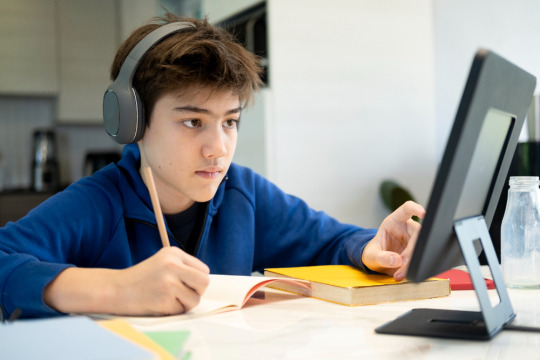
Why Choose Aplus Plus?
Parents often find themselves contemplating whether online learning is the right choice for their children. With Aplus Plus, this concern is addressed through a comprehensive and effective learning solution. Students can save valuable time and focus on their studies without the hassle of commuting. The platform provides access to high-quality resources and experienced educators, ensuring a seamless learning experience.
Courses Offered
Aplus Plus caters to a diverse range of students by offering specialized tuition for various educational boards and curricula:
CBSE Tuition (Grades 6-12)
ICSE/ISC Tuition (Grades 6-12)
IGCSE Tuition (Grades 6-12)
A Level Tuition (Grades 6-12)
IB Tuition (Grades 6-12)
US Curriculum (Grades 1-10)
UK Curriculum (Grades 1-10)
Australian Curriculum (Grades 1-10)
Canadian Curriculum (Grades 1-10)
Subjects Covered
Aplus Plus offers an extensive range of subjects to cater to the diverse academic needs of students. These include:
Mathematics
Science
English
Social Studies
Physics
Chemistry
Biology
Computer Science
Pre-Algebra / Algebra
Pre-Calculus / Calculus
Statistics
Trigonometry
Economics
Accountancy
Business Studies
French
Spanish
Hindi
Exam Coaching
For students preparing for competitive and standardized tests, Aplus Plus provides expert coaching in the following exams:
PSAT Exam
SAT Exam
ACT Exam
AP Test
SSAT Exam
11+ Exam
13+ Exam
NAPLAN Exam
IELTS Exam
TOEFL Exam
NEET Exam
Conclusion
Aplus Plus is dedicated to empowering students with high-quality education tailored to their unique learning needs. By leveraging modern technology and expert instruction, Aplus Plus ensures that students excel academically while enjoying the convenience of learning from home. Whether you are looking for subject-specific tuition or exam preparation, Aplus Plus is your trusted partner in academic success.
Visit more info: https://www.aplusplusonlinetutoring.com/
2 notes
·
View notes
Text

Scarleteen’s fourth digital pride is happening on Friday, June 28th! We're in an extra-super-mega celebratory mood this Pride month because we're in the midst of our 25th anniversary year!
We know that in-person Pride celebrations aren’t accessible or don’t feel safe for everyone, whether that’s because of disability, lack of transportation, or because it’s just not, or doesn’t yet feel, safe for someone to be out in their community. We do a digital Pride every year for many of the same reasons we exist as an online service. While online services aren’t accessible to everyone either, they widen the net substantially, especially for young people, people with disabilities, and rural people, and tend to feel especially safer for folks who want to talk, ask or read about things like sex, sexual identity, sexual health and relationships outside the box, subjects it just isn’t safe to ask just anyone about.
Just like we have during all of our quarter century as an organization and service, we’re focusing this year’s digital Pride on Queer Care. Queer care is the backbone of so much of queer history, culture, and community. We hope you'll join us for music, digital community resource sharing, mini-histories, and AMAs with our queer and trans/gender-nonconforming staff on our sub-reddit and our message boards!
We're inviting anyone who's curious to come by any of our real-time direct services — our boards, text service and live chat — on the 28th, too. Want to experience the kind of education and support our users receive? Get help as a parent or caregiver? Maybe you’re a sex or general educator yourself who wants to find out more about what we do and how we do it, or get help finding some of our content for your own teaching. You can also pop into any of our services just to say hi! Our message boards and text line are always open 24/7, but for Pride, our live chat service will also be open and available all day long!
Happy Pride month, everyone! We hope you’ll join us at the end of it!
6 notes
·
View notes
Text
FIRST ON FOX: The former Missouri teacher who resigned after school administrators found out about her OnlyFans account told Fox News Digital she's made close to $1 million selling porn.
Brianna Coppage, 28, was an English teacher at St. Clair High School, about an hour outside of St. Louis, and was placed on leave before ultimately resigning once administrators discovered her racy side hustle.
Coppage, who made $42,000 working as a teacher, said she used OnlyFans to make extra money that would help her pay off student loans from her advanced degrees.
"I started it, one, to just supplement my income and kind of see what happens and possibly make extra money. Like, I have student loans. I was working on my third degree. So, I also have a master's degree in education, and then I was working on my specialist degree," Coppage told Fox News Digital in an interview.
Coppage was placed on leave in September after meeting with two school administrators who received reports about her OnlyFans account.
"They specifically said they got a report from an adult in the Sullivan School District, and they asked, do I have any other income streams like outside of teaching? And I said, ‘Yes, I do have an OnlyFans.’ They asked how long I had been doing it, if it was during my own time or … anything at school, which I told them."
Coppage said her work on OnlyFans was "completely separate" from her professional life at school.
Kyle Kruse, superintendent of the school district, previously told Fox News Digital administrators were "recently notified that an employee may have posted inappropriate media on one or more internet sites."
"The district has engaged legal counsel to conduct a comprehensive investigation into this matter," Kruse said. "Actions taken as a result of the investigation will be in accordance with board policy and with guidance from legal counsel."
Coppage said she's now among the platform's top creators, raking in nearly $1 million since she began the account over the summer.
"I will also say that I have tens of thousands of fans now. And I have, you know, far exceeded my teacher salary for the year," she said.
The former high school teacher added that if given the opportunity she'd do it again.
"I don't regret it. I still strongly feel that. People are allowed to have personal lives outside of their career. And I've seen a lot of comments like, 'Well, what if the students found it or it's online? People are going to see it.'
"And I don't necessarily disagree with that," she said. "I know for a fact that, one, students are not the ones who found it. They're not the ones who reported it. And they didn't see it until adults posted my link in a community group."
#nunyas news#start saving for retirement#this isn't going to last#and you're going to have a tough time#getting another job now
17 notes
·
View notes
Text
Why You Should Start Playing Chess: The Ultimate Game of Strategy, Focus, and Fun
In a world filled with fast-paced video games and social media distractions, it’s easy to overlook classic games that have stood the test of time. One such game is chess — an ancient board game not only about knights, bishops, and queens, but a powerful tool for mental development and personal growth Whether you’re a complete amateur or curious as the game will resurface, here’s why you should seriously consider chess as a must.

According to a study published in The New England Journal of Medicine , playing strategy-based games such as chess can also help reduce Alzheimer’s risk by keeping the brain active and engaged in the 19th century
2. Enhances Patience and Strategic Thinking In chess, every move counts, and rash decisions can lead to devastating losses. This teaches players the art of not on time gratification — anticipating the appropriate second to strike. By playing chess, you expand strategic foresight and discipline, both of which might be crucial in real-life situations like dealing with a challenge, solving complicated problems, or negotiating offers.
3. Builds Resilience and Emotional Intelligence
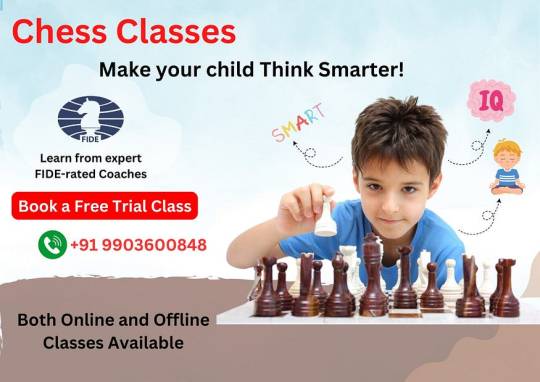
Unlock Your Genius — Join Our Chess Academy!
Online and Offline classes are both Available
Book a Free Trial Class: https://forms.gle/DgEbY1ceMhaNdKwE6
Moreover, chess fosters sportsmanship and respect for others, even in defeat. The lessons learned over the board often translate into real-life interpersonal skills, making you a better communicator and leader.
4. Improves concentration and concentration If you struggle to focus in today’s digital age, chess can be a treat. The game requires unwavering concentration and sharpens your ability to concentrate for long periods of time. Playing chess regularly trains your mind to block out distractions and focus on the task at hand — a skill that can dramatically increase your performance at work or in class.

Even grandmasters like Gary Kasparov and Magnus Carlsen often credit their success to their ability to think clearly under pressure.

7. Chess teaches life lessons Chess is often seen as a metaphor for life. It teaches you to think ahead, adapt to changing circumstances, and balance offense and defense. The game also emphasizes the importance of small, consistent efforts, showing how even small gains over time can accumulate into a winning position.
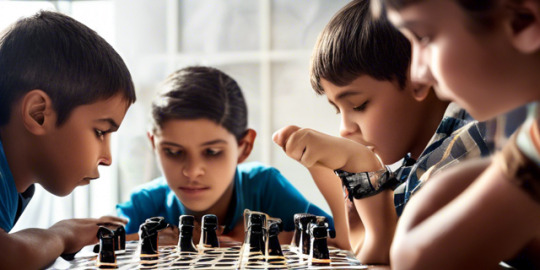
Conclusion: Start your chess journey today Playing chess is not only about moving pieces on the board but about improving your mind, increasing your emotional intelligence, and becoming a critical thinker Whether you want to sharpen your brain, you stop meditation, or you just enjoy a timeless game, chess is a perfect follow up.
So, why not start today? Pick up a chess set or open an online forum, and let the game transform not only your leisure time, but your entire thinking.
Unlock Your Genius — Join Our Chess Academy!
Online and Offline classes are both Available

#chess#chess academy#best chess academy#kids games#mind games#brainstorming#chess class#kids#creatonation
3 notes
·
View notes
Text
Blog #9 Unit 10
As I develop my personal ethic as a nature interpreter, I am reminded of the urgency and responsibility that comes with this role. The world is facing unprecedented environmental challenges, yet our connection to nature is dwindling. As Jacob Rodenburg (2019) mentions, “being an environmental educator in today’s world feels like you are asked to stop a rushing river armed only with a teaspoon”. To further this message, in a climate change discussion presented by the David Suzuki Foundation, it was mentioned that in San Diego, a city surrounded by stunning coastlines, 90% of kids can’t swim, 95% have never been on a boat, and 36% have never even seen the ocean despite living less than 20 minutes away (DavidSuzukiFDN, 2012). Both these points highlight a growing problem that extends beyond just San Diego. It’s a disconnect that, as a nature interpreter, I am committed to solving.
Once I stated this, I realized I might be in over my head by saying “solving” and rather maybe should say alleviate or mitigate. Even with mitigating this gap, I thought where would I start? How can I encourage a generation to care for a world they have rarely even experienced first-hand.
Connecting two worlds: The advantage of my generation:
Being born in the early 2000s, I believe I would have a unique perspective to take this challenge on. I had the advantage of growing up in an environment where outdoor play was common and afternoons were spent exploring the woods, playing sports outside, or simply daydreaming beneath a vast blue sky. I still remember the feeling of endless opportunities while emerging in nature, free of any digital world. During this time, even schooling was different. There was a greater emphasis on hands-on activities, outdoor field trips, and real-world discoveries than on screens and online classes. I have a vivid memory of the evolution of learning boards, which started with plain whiteboards and blackboards, to projectors (figure 1), and then to smartboards and more high-tech equipment.

Figure 1: this is an example of a projector that I still vividly remember my teachers using to give lessons. (Whatever Happened to the Overhead Projector?, 2021)
However, I was still young enough to experience the quick shift to a tech-centric lifestyle. As smartphones, tablets, and social media grew more integrated into our daily lives, I saw firsthand outdoor activities take the backseat. Children today, who have never experienced a world without continual digital connectivity, are missing out on the simple pleasures and deep connections that come from connecting with nature.
This dual perspective gives me an advantage when interpreting nature. I understand what today’s children are drawn to in the digital age, but I also recognize the irreplaceable significant of both hands-on and physical experiences. My goal is to use this insight to develop programs that combine the best of both worlds, utilizing technology to enhance, rather than replace, our relationship with nature.
One of my firm views is that everyone, particularly children, has an innate urge to interact with the natural world. Jacob Rodenburg (2019), highlights this through his experiences that younger children are always eager to appreciate nature, all they need is a chance. He describes taking children to wetlands and seeing their faces light up as they discover salamanders and frogs. These experiences have taught me that the first step in encouraging environmental care is to instill a sense of wonder and curiosity.
Since this is a longer post I want to stop here at halfway and give everyone a break from reading and do this activity:
Think of a place in nature that holds a special memory for you- maybe a childhood park, a hidden trail, or even your backyard. Now think about if that is something children growing up now would experience. What did it teach you? How can you use this place to inspire someone else to love the environment?
As a nature interpreter, my job is not only to inform, but to inspire. Interpretation should aim to create memorable, meaningful experiences that inspire action (Beck et al., 2018). This includes acknowledging that both children and adults need to reconnect with nature on their own terms (Beck et al., 2018). It is not enough to discuss climate change or species extinction. Instead, I want to give hands-on, engaging experiences that will make people care profoundly about the environment around them. I can even do this by incorporating technologies, such as microscopes, magnifying glasses, and telescopes to look at nature. For example, when I was young my dad showed me how you can hold a magnifying glass up to a leaf in the sun, and the leaf will get a hole burnt in it. I still remember this experience to this day.
Here you can see a video of this in action:
https://www.shutterstock.com/video/clip-5804798-scout-burning-leaves-by-loupe-tries-holding
Futher, the identification of global warming as a severe hazard is not a new development. At the 1988 global conference, Steve Lewis and other renowned scientists raised the alarm about the dangers of climate change, urging the world to act. Despite decades of growing scientific data, development has halted and, in some cases, reversed (DavidSuzukiFDN, 2012). This lack of momentum is that the method was frequently based on just providing data and using fear to elicit change, rather than developing compelling, meaningful experiences that could inspire a deeper, long-term connection to the subject.
An interpreting technique that appeals to me is one that mixes storytelling and discovery. Rodenburg's significance on micro-environments serves as an inspiration for me when writing for younger readers (Jacob Rodenburg, 2019). Instead of bombarding children with information about vanishing glaciers or plastic-filled oceans, I can focus on the simple wonders right in their own backyard. For example, how he brought up the idea to take them to a local park and ask, "I wonder who lives under this rock?" so when they lift it and discover a wiggling earthworm or a little salamander, they feel as if that was their own discovery (Jacob Rodenburg, 2019). It's a time of pure exhilaration, where the thrill of discovery creates a deeper, more personal relationship to nature, instilling an actual care for the environment.

I also believe in the power of storytelling. By crafting narratives about the plants, animals, and landscapes around us, I can turn facts into intriguing stories that pique the imagination. This strategy not only makes knowledge more memorable, but it also helps people create a stronger emotional bond with their surroundings by transforming abstract concepts into relatable, lived experiences (Beck et al., 2018).
Quick interactive moment: What's one tiny thing you can do today to reconnect with nature? It may be as simple as planting a flower, clearing up trash. or taking a few minutes tonight to observe the stars.
References
Beck, L., Beck, L., Cable, T. T., & Knudson, D. M. (2018). Interpreting cultural and natural heritage: For a Better World.
DavidSuzukiFDN. (2012, July 20). David Suzuki and Richard Louv @AGO [Video]. YouTube. https://www.youtube.com/watch?v=F5DI1Ffdl6Y
Jacob Rodenburg. (2019, June 17). Why environmental educators shouldn’t give up hope | CLEARING: PNW Journal of Environmental Education in the Pacific Northwest. https://clearingmagazine.org/archives/14300
Whatever happened to the overhead projector? (2021, November 15). Larry Cuban on School Reform and Classroom Practice. https://larrycuban.wordpress.com/2021/11/15/whatever-happened-to-the-overhead-projector/
4 notes
·
View notes
Text
Printed Circuit Board Basics
Most of us are using Printed Circuit Board in our daily life. Printed Circuit Boards are used in almost all the Electronic products, from consumer gadgets such as PCs, tablets, smartphones, and gaming consoles to industrial and even high tech products in strategic and medical electronics domains.
Here, we have some statistics for you that shows how many electronic devices connect worldwide from 2015 to 2025. This statistic shows an increase in the use of a number of PCB in people daily life. Hence, CircuitWala took this opportunity to provide a basic knowledge about PCB via this article.
There are so many books available online which teach about Printed Circuit Board design and hardware part. There are few links available online which shows only a few basic fundamentals of PCB and few are there for Basics of Printed Circuit Board (PCB) Design. Few which gives good know knowledge on Printed Circuit Board terminology. But in the end for the hobbyist, there is no such material available which make their work easy.
Now days there few online designing websites available which allow hobbyist and students to create their design and Printed Circuit Board fabrication part. These websites provide limited features and charge high for the full edition. We, @CircuitWala are in try to provide one platform which provides plenty of Printed Circuit Board knowledge digitally to make your work simple and easy.
Alternatives of PCB include wire wrap and point-to-point construction. Creating a layout of PCB is a little bit time-consuming method as compared to its alternative solution but manufacturing of PCB is cheaper and faster then other wiring methods as electronic components are mounted and wired with one single part.
Let’s start with some basics of Printed Circuit Board with this article. Here in this article we will discuss about history of PCB to understand the emerge of PCB, Types of PCB to make your complex PCB a very simple using different types, Usage of PCB to provide you an idea to create more Printed Circuit Board projects, Advantages and Disadvantages, Possible Future to know about new technological change in Printed Circuit Board manufacturing and also about how to destroy and manage your PCB’s e-waste? We know you are eager to know all the stuff in details but before that let’s make a simple definition of Printed Circuit Board.
What is Printed Circuit Board?Printed Circuit Board is an electronic device made of conductive material(FR-4) like copper which connects components mounted on it to to get desired output by providing an input on another end.
When the board has not mounted with any of the components is called as Printed Circuit Board or Printed Wired Board. Mounting of an electronic component on Printed Circuit Board is called as PCB assembly.
History of Printed Circuit BoardThe invention of Printed Circuit Board was by Austrian engineer Paul Eisler as part of a radio set while working in England around 1936.
In early days before Printed Circuit Board became common in use, Point-to-Point construction was used. This meant some bulky and unreliable design that required plenty of sockets and regular replacement of it. Most of this issue directly address when PCB went into regular production.
Originally, every electronic component had wire leads, and the PCB had holes drilled for each wire of each component. The components’ leads were then passed through the holes and soldered to the PCB trace. This method of assembly is called Through-Hole construction. There is one other method to mount component is called as Surface Mount.
Type of Printed Circuit BoardPCBs are produced from the different types of material and on the basis of that material PCBs are divided mainly into two parts: Rigid PCB and Flexible PCB. Nowadays, a combination of Rigid and flexible PCB is also possible and that is called as Flexi-Rigid PCBs.
Most of the PCBs are built in layers. The inner layer is the base material called as a substrate. Rigid PCBs are mainly made of material like epoxy materials and Flexible PCBs are made of plastic material that can withstand high temperatures.
Rigid PCBs are generally, hard materials that hold the component in a better way. The motherboard in the tower of a computer is the best example of Rigid PCBs. Flexible PCBs fundamental material allows PCB to fit into forms that Rigid PCBs can not. Flexible PCBs can turn round without harmful the circuit on PCB.
All Rigid and Flexible PCBs can come in three formats by layers: Single Layer, Double Layer, and Multi-Layer.
1. Single Layer PCBSingle Layer PCBs have been around since the late 1950s and still dominate the world market in sheer piece volume. Single Sided PCBs contain only one layer of conductive material and are best suited for low-density designs. Single-sided PCBs are easy to design and quick to manufacture. They serve as the most lucrative platform in the industry.
2. Double Layer PCBDouble Layered printed circuit board technology is conceivably the most popular type of PCB in the industry. Double Sided PCB (also known as Double-Sided Plated Thru or DSPT) circuits are the gateway to advanced technology applications. They allow for a closer (and perhaps more) routing traces by alternating between top and bottom layers using vias.
3. Multi Layer PCB
Multilayer PCB is a circuit board that has more than two layers. Unlike a Double-Sided PCB which only has two conductive layers of material, all multilayer PCBs must have at least three layers of conductive material which are buried in the center of the material.
Usage of Printed Circuit BoardBy reading this article till this point, we hope that you are now able to get about printed circuit boards. Now, we will make you understand about different applications of printed Circuit Board.
In this digital world, Printed Circuit Board is in almost all our daily life electronic devices and in our industrial electronics as well. Below are the industries where PCBs are used:
Possible FutureNowadays, most of the circuits are replaced to produce Printed Circuit Board from the old methods. Revolution in technology made many of the processes automated and hence it is easy to manufacture PCB. But still, these processes are a bit expensive to hire, involve toxic waste and use high temperatures and acids. With technological advances we have seen in the past years, it is not hard to imagine PCB will soon be revolutionized. Not only that but research institutes predict a more ‘green’ future for PCBs; PCBs being made of paper.
Electronic Waste (e-waste)Electronic Waste or e-waste is described as discarded electrical or electronic devices. Informal processing of e-waste in developing countries can lead to adverse human health effects and environmental pollution.
Electronic scrap components contain a hazardous substance such as lead, cadmium, beryllium, or brominated flame retardants. Recycling and disposal of e-waste may involve significant risk to health of workers and communities in developed countries and great care must be taken to avoid unsafe exposure in recycling operations
Nowadays, developing countries are encouraging electronic users to take care while recycling the e-waste or submit them to the organization who are involved in such activities.
SummaryIn this blog, we have learned the basics of Printed Circuit Board. CircuitWala is planning to write as many blogs to provide more and more knowledge of Printed Circuit Board. Either it is basics or manufacturing or usages or advantages and disadvantages of PCBs. We will also try to make our users/customers up to date for the new technology innovations, including past histories and revolution of the PCB industries.
In the next blog, we will look at more briefly about the different types of Printed Circuit Board. We also understand the process to make it and different usage and application for the same.
#electronic circuit design company#pcb circuit manufacturer in ahmedabad#pcb design & manufacturing services#printed circuit board companies#printed circuit board order online#PCB manufacturer#Printed Circuited Board#double layer PCB#PCB Quality Control
2 notes
·
View notes
Text
Digital board services
Experience the future of brainstorming and ideation with our digital board services, empowering teams to visualize ideas, share feedback, and drive innovation.
https://digitalboard.org.in/
0 notes
Text
Raspberry Pi Board: Revolutionizing Computing and Education
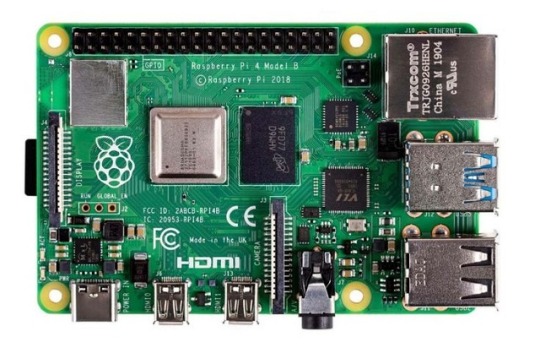
The Raspberry Pi board is a series of small, affordable single-board computers developed by the Raspberry Pi Foundation, a UK-based charity focused on promoting computer science education and digital literacy. Since its launch in 2012, the Raspberry Pi has transformed from a niche educational tool into a versatile platform used in a wide range of applications, from DIY electronics projects to industrial automation.
A Brief History
The first Raspberry Pi, the Model B, was released in February 2012. Designed to promote basic computer science in schools and developing countries, it featured a 700 MHz ARM11 processor, 256 MB of RAM, and basic connectivity options. The success of the Model B led to a rapid expansion of the Raspberry Pi lineup, with various models offering improved performance, more memory, and enhanced connectivity.
Key Features and Models
Raspberry Pi 1 Model B (2012):
Processor: 700 MHz ARM11
Memory: 256 MB RAM
Ports: 2 USB 2.0 ports, HDMI, Composite video, 3.5mm audio jack, Ethernet
Storage: SD card slot
Raspberry Pi 2 Model B (2015):
Processor: 900 MHz quad-core ARM Cortex-A7
Memory: 1 GB RAM
Ports: 4 USB 2.0 ports, HDMI, Composite video, 3.5mm audio jack, Ethernet
Storage: MicroSD card slot
Raspberry Pi 3 Model B (2016):
Processor: 1.2 GHz quad-core ARM Cortex-A53
Memory: 1 GB RAM
Ports: 4 USB 2.0 ports, HDMI, Composite video, 3.5mm audio jack, Ethernet
Wireless: Wi-Fi and Bluetooth
Raspberry Pi 4 Model B (2019):
Processor: 1.5 GHz quad-core ARM Cortex-A72
Memory: Options of 2 GB, 4 GB, and 8 GB RAM
Ports: 2 USB 3.0 ports, 2 USB 2.0 ports, 2 Micro HDMI ports, Ethernet, USB-C for power
Wireless: Wi-Fi and Bluetooth
Raspberry Pi Zero (2015) and Zero W (2017):
Processor: 1 GHz single-core ARM11
Memory: 512 MB RAM
Ports: Mini HDMI, Micro USB OTG, Micro USB for power, GPIO pins
Wireless (Zero W): Wi-Fi and Bluetooth
Applications and Uses
The versatility of the Raspberry Pi has led to its adoption in numerous fields:
Education:
Coding and Programming: Used in schools and educational programs to teach students programming languages such as Python, Scratch, and Java.
Computer Science Concepts: Introduces concepts like hardware, software, and networking.
DIY Projects and Maker Community:
Home Automation: Controls smart home devices, including lights, thermostats, and security systems.
Media Centers: Powers home media centers using software like Kodi.
Retro Gaming: Emulates classic gaming consoles using software like RetroPie.
Industrial and Commercial Applications:
IoT Devices: Serves as a hub for Internet of Things (IoT) devices, enabling data collection and remote control.
Automation and Control Systems: Used in factories and labs for monitoring and controlling equipment.
Research and Development:
Prototyping: Facilitates rapid prototyping of electronic devices and systems.
Data Collection: Gathers data from various sensors in environmental and scientific research.
Community and Ecosystem
The Raspberry Pi has cultivated a vibrant global community of developers, hobbyists, educators, and students. Online forums, tutorials, and community projects provide extensive support and resources for users at all skill levels. The Raspberry Pi Foundation also offers official accessories, including cases, cameras, and expansion boards, further enhancing the functionality of the Raspberry Pi.
Conclusion
The Raspberry Pi board has revolutionized the way people learn about and interact with technology. Its affordability, versatility, and extensive support network have made it an indispensable tool in education, DIY projects, and professional applications. As technology continues to evolve, the Raspberry Pi Foundation remains committed to expanding the capabilities and accessibility of this remarkable platform, ensuring that computing remains within reach for everyone.
2 notes
·
View notes
Text
I gotta rant about the state of math education for a minute. I say this as a math educator with a math PhD who currently works to create digital math content and assessments (primarily for high school and college level). We have to do better for students and the way we're attempting to do that is mostly garbage because of publishing companies.
I currently work for two educational publishers who will remain unnamed. They're competitors and I think it's funny that I and one other person I know work for both of them.
Anyway, company M, who I primarily work for, is finding that students are using fewer of their tools and appear to just guess when they don't know an answer instead of attempting and getting feedback. Instead of figuring out what would actually help students, this company is taking a more bare bones approach to authoring math assessment tools going forward, firing authors (the team I was on used to have over 20 people at any given time and now there are 4 of us), and then complaining how we can't keep up with authoring new content. The problem is that they are not offering a wider variety of content for different types of learners, but they don't want to hear that. They write a textbook, make online homework and study guides for it, and call it good. That's not nearly enough, but they don't want to invest in getting better.
This week I started training for a new part time job at company C to try to make a little more money and they are trying to do a better job. They want higher student engagement, fewer assessments, and for students to explore a topic instead of traditional lectures. Great. Research supports a more interactive approach to learning. Except their idea of student engagement and interaction solely focuses on extroversion: reading, writing, conversing, analyzing, actively listening, group work, sharing with the class, and more. And none of it has the options of being done alone. On top of this, they do not address disabilities and are only just starting to realize they need different content for multilingual learners.
Some students can actually read and learn and do not need to interact. Some students are anxious to interact. I've seen it. I've had a student stuttering just trying to talk in class to ask a question, and making her come to the board? Why? For what purpose? Said student was already doing well in class and she simply wrote everything out. I had multiple students who were combat veterans; one in particular who had a brain injury and needed a lot of repetition. Having a lot of approaches in a 50 minute class would have been overwhelming for him since he needed clear examples and lots of independent practice. He thrived in my office hours. Forcing this model will not help these students. While I think there are some good things about this versus just using a digital textbook, I take issue with the approach because it is still forcing students to all learn the same way. It's a different way of learning than using a textbook, but there is no room for flexibility.
Look, I know that it's impossible to teach a classroom of students in a way that gives each enough time and resources to perfectly meet their needs. I taught at a university for 8 years. I've tutored students in grades 3-12 for over a decade. This is not me bashing teachers, lecturers, or professors. I know they are simply limited to what math ed materials are on the market and what they write themselves. (Thinking of Dr. Bell who wrote his own book for Modern Algebra because he hated every book on the market.) I just get frustrated when everyone (publishers) tries to push new teaching styles and tools, saying "there are multiple approaches to suit multiple learners." If each student must go through and master each approach, how is that any better than saying they must all master this one approach?
I'm just a frustrated math lady. Also, this has reminded me of the time many years ago when I had an anon who would ask for math homework help in my inbox because they had no where else to go. That was also before we had DMing on tumblr. Thinking of you today, Stats Anon.
#math#math education#about me#math publishing#so many educators out there trying their best and the materials they have to work with are just not enough#the answer to this is probably increase funding for education
9 notes
·
View notes